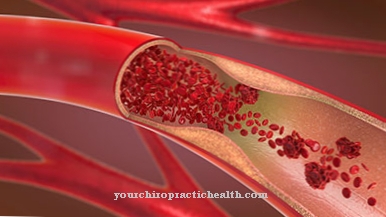Cellulite or Orange peel is a rather unloved term for most people. According to statistics, every third woman over the age of 20 worldwide suffers from unsightly "dents" on her buttocks and thighs. But what causes cellulite? And how can this be avoided or treated?
What is cellulite (orange peel)?
.jpg)
Cellulite, too, often Cellulite or orange peel, is a phenomenon that women in particular have to struggle with as they age.
Cellulite affects younger women somewhat less often, but still relatively often. Men very seldom suffer from slackening of the connective tissue in the problem areas typical of cellulitis.
These cellulite problem areas mostly consist of the bottom and thighs. Other parts of the body are not affected by cellulite quite as often.
causes
Probably the most common cause of cellulite is basically very easy to name with the skin and tissue of women. Because with women this is already much more loosely woven in younger years than it is comparatively the case with men. Over the years this structure and strength can “deteriorate” even further. Women continue to have higher levels of body fat than men.
In addition, it is not uncommon for the upper female skin layers to be much finer and thinner than the male skin layers. Fat cells can therefore reach the tissue surface through these cells much more easily over time. The result is unsightly and dent-like deformations of the skin surface.
The close resemblance of these deformations to the surface of an orange gave cellulite its nickname orange peel.
Symptoms, ailments & signs
Cellulite or orange peel is a very widespread phenomenon from which almost all women and proportionally far fewer men suffer. It has no disease value, but is one of the optical characteristics. Therefore, their symptoms and complaints are also more psychological - whenever the person concerned begins to suffer from the unsightly appearance of the deformed skin. This can lead to depression.
The classic symptoms of orange peel are unsightly dents in the skin. They can typically be found where the skin stores more fat anyway. Female problem areas are mainly found on the thighs, but also on the buttocks and stomach. Cellulite is also found to an advanced degree on the upper arms, neck and décolleté.
Cellulite is usually perceived more visually when the person is in motion, i.e. when the skin over the muscles is also moving. Now the dents and deformations are particularly visible. If there is any uncertainty, the pinch test can help make the diagnosis: two fingers are used to grasp about five centimeters of tissue and lift it slightly. Under this pressure, the dents are usually very visible. If you let go of the skin, it returns to its original shape. The cellulite is painless.
course
Cellulite usually occurs very slowly, as the fat deposits of the body gradually sniff through the loose tissue to the surface and thus directly under the upper layers of the skin.
Women who are slightly or heavily overweight are also more often affected. Because: There are significantly more fat cells here that can "wander" with cellulite. However, women with an ideal weight or a slim waist are not entirely safe.
Cellulite can occur completely unexpectedly, can be inherited in a family or not entirely. It always depends entirely on the tissue quality of the person affected. Not infrequently, however, cellulite also occurs as a result of a too fast and radical diet, whereby the tissue and the skin cannot adapt as quickly.
Complications
Cellulite does not usually lead to medical complications without treatment. The only exception is if it is not “real” cellulite but orange peel (peau d'orange). This can occur in various diseases such as Hunter's disease, myxedema and inflammatory breast cancer. These underlying diseases, in turn, can lead to various physical complications.
However, many women perceive cellulite as a cosmetic problem. Particularly in connection with low self-esteem, this can lead to more severe psychological complications. Some sufferers feel a desire to hide their bodies because of the cellulite. They may only wear certain clothes and avoid going to swimming pools.
However, various medical complications are also possible in treating cellulite. Fasts and baths can cause circulatory problems, while ointments and creams in some cases cause skin reactions. Infections are also possible during invasive procedures that are intended to treat cellulite.
For this reason, it is important to carefully weigh the pros and cons of cellulite treatment. This is especially true for interventions that can have far-reaching consequences. One example of this are hormonal treatments that only target cellulite. In some cases, psychological treatment makes more sense. As a rule, the aim of this is to get those affected to accept their own body, even with small blemishes.
When should you go to the doctor?
Cellulite does not pose a health risk, but the effects on the psyche should not be underestimated. Younger women in particular suffer from Some of them are significantly under the effects of their orange peel and feel very restricted on hot days because they have difficulty showing their skin.
The family doctor can easily make the diagnosis and suggest suitable therapies. For more radical methods such as cryolysis or laser, ultrasound and cold therapy, however, the general practitioner usually does not have the necessary machines. So anyone who suffers particularly from cellulite should visit a dermatologist and get advice on the most efficient treatment options. Unfortunately, you have to pay the costs for the therapy yourself, as the health insurance companies consider such interventions as cosmetic, which are not necessary for health reasons.
Doctors & therapists in your area
Treatment & Therapy
There is still no one hundred percent successful treatment for cellulite. Only various plastic surgery interventions can make the unsightly dents almost completely disappear in a short time - but not in the long term with the right aftercare. However, under various circumstances, the appearance of cellulite can be kept within limits by a good mixture of a healthy diet, a balanced exercise program and the right care for the skin, and its strength can also be reduced after it occurs.
Creams, pastes and the like still only provide limited relief and should rather be used to support an appropriate lifestyle. However, anyone who only counts on chemical agents, which usually only promise unrealizable miracles, will likely be disappointed very quickly.
It is true that these beauty creams achieve a positive result. However, since most of these agents only work on the surface of the skin and not on the cause of the problem - in the lower skin and tissue layers - the visible result with cellulite is usually rather mediocre to poor.
Outlook & forecast
The prognosis for cellulites is classified as stable. Despite many efforts, there are usually no significant changes in the state of health. In most cases, the tissue deformations remain constant over many years.
In the course of life, the natural aging process leads to a continuous decrease in tissue tension. If there is optimal health care and if enough sport is done, the existing condition of the tissue can be maintained for a long time. A healthy lifestyle and a balanced diet are the best prerequisites so that dents in the tissue do not deteriorate soon. The prognosis for cellulite changes in people who are very overweight and have a diet high in fat. The intensity of the dents increases automatically as the weight increases.
Despite numerous medical efforts and methods offered, a complete cure of cellulite is not possible with the current state of science. Often, various techniques are used to alleviate the symptoms that are present and achieve individual success. However, the improvements in the fabric are not lasting. They usually last for a few weeks or months until the cellulite is restored to its original state. With surgery, visual improvements can last for up to a year.
prevention
The best prevention against cellulite is a healthy lifestyle. Regular exercise, a healthy diet and avoidance of excess weight are the best remedies for cellulite in the long run. Brush massages of the affected areas and regular alternating showers are also very helpful. For this, however, women should ideally start a mature preventive program at a young age.
Because: when the first drastic signs of cellulite can be seen, it is usually too late for targeted preventive care. HYPOXI® techniques are available to those affected by means of Hypoxi trainers as commercial treatment and preventive measures. Similar to altitude training, this is based on athletic training with negative pressure.
Aftercare
If cellulite treatment was carried out on an outpatient basis, no special aftercare is usually required. It is important not to scratch the treated areas, otherwise the healing process could be disrupted. In addition, immediately after cellulite treatment, you should not bathe or shower.
However, it is recommended that you drink two to three liters of water a day and apply a good moisturizer. Those who take in as much fluid as possible can stimulate their metabolism, promote the healing process and achieve optimal treatment results. The regeneration of deeper skin layers is supported by special moisturizing creams.
In addition, cigarettes, alcohol, saunas and sunbathing should be avoided, especially shortly after the treatment, as alcohol and nicotine slow down the metabolism. If it is not possible to avoid exposure to the sun, a sunscreen with a very high sun protection factor should be applied. If pain occurs in the first few days after treatment, it can be relieved with painkillers.
However, anti-inflammatory drugs or drugs that thin the blood can increase the risk of bruising. There is no need to change your diet after cellulite treatment. The practice of sporting activities should best be discussed with the attending physician.
You can do that yourself
Although orange peel is ultimately genetically determined, those affected can still do something to alleviate these skin changes, which are now perceived as negative.
People who are overweight should first of all normalize their weight. Cellulite usually recedes by itself, especially on the stomach. On the other hand, dents on the thighs and on the bottom are far more persistent. Targeted exercises to strengthen the muscles and reduce fat mass can also improve the orange peel. Training can be particularly effective in fitness studios. Here the most effective exercises are explained to those affected and an individual training plan is created. Those who prefer to do free sport should try endurance sports such as walking, cycling or swimming.
A healthy, low-fat diet is also important. This should be largely vegetarian or vegan and, in addition to a lot of fruit and vegetables, also contain high-fiber whole grain products. Refined sugar, animal fats as well as meat and sausage products are considered counterproductive. Many women also achieve visible results with drinking cures lasting several weeks. As part of such cures, at least three liters of mineral water or unsweetened herbal tea should be consumed per day.
Dry brush massages are also helpful. The effect of such massages can allegedly be improved by the use of special creams and ointments. However, the effect of cosmetic anti-cellulite products is highly controversial.
Those affected who suffer from severe psychological orange peel should seek therapeutic help in good time.

.jpg)
.jpg)



.jpg)






.jpg)

.jpg)
.jpg)











.jpg)